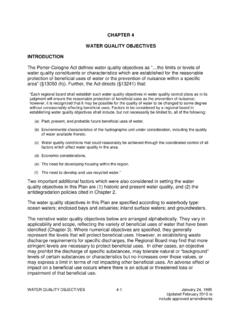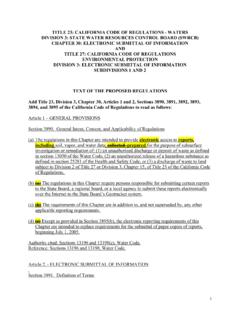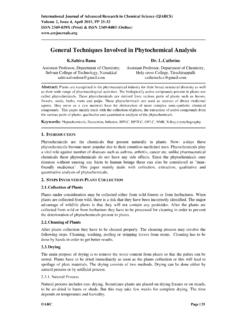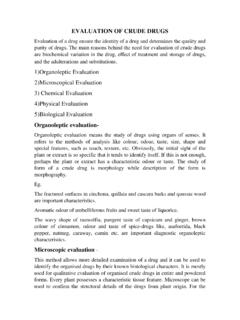Transcription of 3.1.5.9 Fact Sheet - Water Color - California
1 State Water Resources Control Board FACT Sheet Clean Water Team Color of Water Fact Sheet INTRODUCTION Suspended and dissolved particles in Water influence Color . Suspended material in Water bodies may be a result of natural causes and/or human activity. Transparent Water with a low accumulation of dissolved materials appears blue and indicates low productivity. Dissolved organic matter, such as humus, peat or decaying plant matter, can produce a yellow or brown Color .
2 Some algae or dinoflagellates produce reddish or deep yellow waters. Water rich in phytoplankton and other algae usually appears green. Soil runoff produces a variety of yellow, red, brown and gray colors. Weathered rocks and soils, the land-use activity and the type of trees and plants growing within the watershed will influence the types and amount of dissolved and suspended material found in a lake or stream. Color may also be affected by the concentration of natural dissolved organic acids such as tannins and lignins, which give Water a tea Color .
3 These are formed when plant material is slowly broken down by organisms into very small particles that are dissolved into Water . tannins that are yellow to black in Color are the most abundant kind found in lakes and streams and can have a great influence on Water Color . Lakes that are surrounded by coniferous forests (evergreens such as pine, spruce, hemlock and fir trees) are generally brown in Color because pine needles that fall to the ground are very slow to degrade. This is also true of lakes surrounded by wetlands, where plants decompose very slowly.
4 Naturally occurring organic compounds such as tannins and lignins, derived from the decomposition of plant and animal matter, can give surface Water and groundwater a tea-like yellow-brown hue, as well as a musty smell, is known for its "root beer" Color . The brown coloring comes from tannins leaching into runoff Water from tree roots and decaying vegetation. This coloration is common, and can be observed in places like swamps or stagnant ponds. A person can produce it by placing some leaves in a bucket of Water and letting it set for a few weeks.
5 APPARENT AND TRUE Color OF Water Accurate documentation of Water Color is important as it indicates source of Water and pollutants. Water Color is referred as apparent Color and true Color based on the type of solid material present in it. Apparent Color is the Color of the whole Water sample, and consists of Color due to both dissolved and suspended components. True Color is measured by filtering the Water sample to remove all suspended material, and measuring the Color of the filtered Water , which represents Color due to dissolved components.
6 CAUSES OF COLORATION State Water Resources Control Board FACT Sheet Clean Water Team Several natural and artificial causes are responsible for an existing Water Color . The most favorable environments for high coloration include elevated organic activity with algal growth and presence of soluble minerals in the vicinity of a Water body. Algae growth Before or during decomposition, algae may impart a green, brown or even reddish Color to the Water .
7 Algae can grow in lakes, streams, canals, and even in wells and Water pipes. This growth can produce hues varying from a pea-soup green to a reddish brown. At high concentrations, algae can produce an unpleasant "pond scum" that can reduce consumer confidence if the Water is used as a source of drinking Water , and can clog pumps where the Water is used for irrigation. Algal blooms also can degrade the visual appeal of a waterbody, and negatively affect its ecology by consuming dissolved oxygen as the algal mats decay.
8 In some cases, the decay produces a bad odor from the release of methane gas. Minerals Perhaps the most common cause of Water Color is the presence minerals. Red and brown colors are due to iron; black to manganese or organic matter; and yellow to dissolved organic matter such as tannins . Iron and manganese are common, at least in small amounts, in most rocks and sediments. In groundwater that contains abundant dissolved oxygen, iron and manganese form solid mineral phases and cannot be dissolved to any extent.
9 In some groundwater, however, there is a limited amount or no oxygen present. Under that condition, iron and manganese dissolve in the Water . When this Water is pumped from the well, it encounters oxygen from the atmosphere, and these elements precipitate as very small particles of iron hydroxide and/or manganese hydroxide minerals. The yellow Color associated with natural dissolved organic matter ( , tannins ) may result when rainwater or runoff leaches this organic matter from leaves, roots, and other vegetative matter, and flushes it down to the aquifer supplying a well.
10 The coloration both from iron and manganese and from dissolved organic carbon may occur seasonally. Insoluble oxidized iron (rust) can give Water a red tint, manganese oxide causes a black discoloration, and a combination of the two can yield a yellow-brown hue. IMPACTS Color of Water is referred as colorless and the firs impact of coloration is aesthetics. State Water Resources Control Board FACT Sheet Clean Water Team Colorless Water is considered pure though it may be unsafe for human health.














